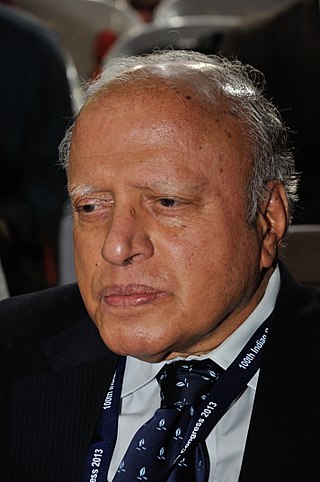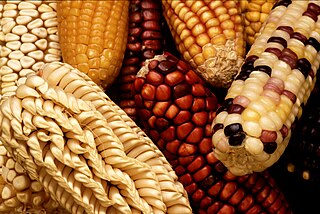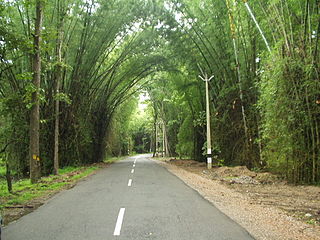
Wayanad is a district in the north-east of the Indian state of Kerala, with its administrative headquarters at the municipality of Kalpetta. It is the only plateau in Kerala. The Wayanad Plateau forms a continuation of the Mysore Plateau, the southern portion of the Deccan Plateau. It is set high in the Western Ghats with altitudes ranging from 700 to 2,100 meters. Vellari Mala, a 2,240 m (7,349 ft) high peak situated on the trijunction of Wayanad, Malappuram, and Kozhikode districts, is the highest point in Wayanad district. The district was formed on 1 November 1980 as the 12th district in Kerala, by carving out areas from Kozhikode and Kannur districts. An area of 885.92 km2 in the district is forested. Wayanad has three municipal towns—Kalpetta, Mananthavady and Sulthan Bathery. There are many indigenous tribes in this area. The Kabini River, a tributary of the Kaveri River, originates at Wayanad. Wayanad district, along with the Chaliyar valley in the neighbouring Nilambur in Malappuram district, is known for natural gold fields, which are also seen in other parts of the Nilgiri Biosphere Reserve. The Chaliyar river, which is the fourth longest river of Kerala, originates on the Wayanad plateau. The historically important Edakkal Caves are located in Wayanad district.

Bharat Ratna Mankombu Sambasivan Swaminathan was an Indian agronomist, agricultural scientist, geneticist, administrator and humanitarian. Swaminathan was a global leader of the green revolution. He has been called the main architect of the green revolution in India for his leadership and role in introducing and further developing high-yielding varieties of wheat and rice.

Mananthavady is a municipality, taluk and town in the Wayanad district of Kerala, India. The municipal boundaries are defined by Tirunelli Panchayat to the north, Kabani River to the east and south, and Thavinhal Panchayat to the west. Mananthavady is the third largest town in Wayanad District, following Sulthan Bathery and Kalpetta. It is situated 35 km northeast of the district headquarters, Kalpetta, 80 km east of Thalassery, and 110 km northeast of Kozhikode.

Agricultural biodiversity or agrobiodiversity is a subset of general biodiversity pertaining to agriculture. It can be defined as "the variety and variability of animals, plants and micro-organisms at the genetic, species and ecosystem levels that sustain the ecosystem structures, functions and processes in and around production systems, and that provide food and non-food agricultural products.” It is managed by farmers, pastoralists, fishers and forest dwellers, agrobiodiversity provides stability, adaptability and resilience and constitutes a key element of the livelihood strategies of rural communities throughout the world. Agrobiodiversity is central to sustainable food systems and sustainable diets. The use of agricultural biodiversity can contribute to food security, nutrition security, and livelihood security, and it is critical for climate adaptation and climate mitigation.

An heirloom plant, heirloom variety, heritage fruit, or heirloom vegetable is an old cultivar of a plant used for food that is grown and maintained by gardeners and farmers, particularly in isolated communities of the Western world. These were commonly grown during earlier periods in human history, but are not used in modern large-scale agriculture.
Mankombu or Moncombu is a village in the district of Alappuzha in the state of Kerala, India. Monkombu, part of the Kuttanad delta region popularly mentioned as 'Rice bowl of Kerala'; is one of the major paddy cultivation regions of the state. Its unique geography embodied by Vembanad lake, inter-linked Pambaa, Manimala and Achenkovil river systems, gives rise to islands, back waters, network of waterways and canals, below sea-level paddy fields and marsh. The farmers here have met the challenges of below sea-level cultivation over two centuries. Annual festivals, auspicious rites and religious events at Mankombu Bhagavathi Devi temple, St.Pius church and Pope John Paul Church are occasions for social communion, rejoicing and celebration. Once a prosperous hamlet of hundreds of households, Mankombu today is ravaged by climate change, pollution and dwindling population.
The M. S. Swaminathan Research Foundation (MSSRF) is a nonprofit NGO trust based in Chennai, India. It develops and promotes strategies for economic growth that directly target increased employment of poor women in rural areas. Their methods maximize the use of science and technology for equitable and sustainable social development and environmental stability. The MSSRF logo signifies continuity and change, invoking the DNA model of open-ended, many-sided, and continuous evolution.
Upland rice is rice grown in dry-land environments. The term describes varieties of rice developed for rain-fed or less-intensely irrigated soil instead of flooded rice paddy fields or rice grown outside of paddies.

Ambalavayal is a village in Wayanad district in the state of Kerala, India. The Wayanad Heritage Museum is located in the village.

The Thalassery cuisine refers to the distinct cuisine from Thalassery city of northern Kerala, which has blended in Arabian, Persian, Indian and European styles of cooking as a result of its long history as a maritime trading post.
Agricultural Research Station, Mannuthy is a research Station under the Central Zone of Kerala Agricultural University at Mannuthy in Thrissur districts of Kerala, India. This station was established in 1957 as Rice Research Station. Later in 1972 after the formation of Kerala Agricultural University the Rice Research Station along with the Agricultural Research Station brought under the control of KAU. The rice research station and agricultural research stations were merged in 1976 and renamed as Agricultural Research Station, Mannuthy.
Kerala State Biodiversity Board (KSBB)

Meenangadi is an old town situated on the highway NH 766 between Kalpetta and Sulthan Bathery in Wayanad District, in Kerala, India. This place is one among the Provinces where the existence of Dolmens provide an historical evidence of earlier civilisation. Coffee bean, Black pepper, Ginger, Rice and Areca are the major crops cultivated in this area. Meenangadi is famous for its Fish Market and Cattle Market. The nearest railway station is at Kozhikode at 87 km and airport is Kannur International Airport with 94 km from Meenangadi. Meenangadi is surrounded by, Ambalavayal Panchayat, Kalpetta Taluk towards west, Gudalur Taluk towards East, Mananthavady Taluk towards west. Kalpetta, Sultan Bathery, Kozhikode are the nearby Cities and towns to Meenangadi.
Kerala's first carbon neutrality project launched in Meenangadi in June 2016. Upon achieving the goals of the project, Meenangadi will be the first village in India to go completely carbon neutral. Meenangadi has a population of 33450 According to 2011 Census with two Villages Purakkadi and (Part)Krishnagiri.

Kalanamak is a scented rice of Nepal and India. Its name means black husk. This variety has been in cultivation since the original Buddhist period. It is popular in Himalayan Tarai of Nepal i.e., Kapilvastu, and eastern Uttar Pradesh, where it is known as the scented black pearl. It was featured in the book Speciality rices of the world by Food and Agriculture Organization of the United Nations.
The Seed Savers' Network (SSN) is an Australian not-for-profit organisation, based in Byron Bay, New South Wales. Since 1986, SSN has organised gardeners and farmers to collect, multiply and redistribute garden seeds in Australia and also within peasant organisations worldwide.
Wayanad Jeerakasala rice is a variety of traditional, non-Basmati, medium-grained aromatic rice with golden yellow colour mainly grown in the Indian state of Kerala. It is a common and widely cultivated crop in Wayanad district. Wayanad Gandhakasala rice is known for its sandalwood-like flavor, while Wayanad Jeerakasala rice resembles cumin seeds in both appearance and taste and are so unique from one another.

The Wayanad District of Kerala, India has a wide variety of tourist attractions ranging from religious sites to natural and historical sites. This district is divided into three towns: Kalpetta, Sultan Bathery and Mananthavady. All Major Tourism destinations in the district are maintained by the District Tourism Promotion Council.
Koraput Kalajeera rice is a variety of non-Basmati, aromatic, black paddy coloured, small rice mainly grown in the Indian state of Odisha. It is a common and widely cultivated crop in the Koraput district of Odisha as well as Nabarangapur district which was earlier a part of Koraput. For thousands of years, the ancestors of Koraput's present tribal communities have cultivated and domesticated Kalajeera rice, playing a crucial role in its conservation.

![Gandhakasala rice packaged by KAU gndhkshaal ari kaa[?]ssiks[?]vklaashaalyutte oonnvipnniyi[?].JPG](http://upload.wikimedia.org/wikipedia/commons/thumb/9/98/%E0%B4%97%E0%B4%A8%E0%B5%8D%E0%B4%A7%E0%B4%95%E0%B4%B6%E0%B4%BE%E0%B4%B2_%E0%B4%85%E0%B4%B0%E0%B4%BF_%E0%B4%95%E0%B4%BE%E0%B5%BC%E0%B4%B7%E0%B4%BF%E0%B4%95%E0%B4%B8%E0%B5%BC%E0%B4%B5%E0%B4%95%E0%B4%B2%E0%B4%BE%E0%B4%B6%E0%B4%BE%E0%B4%B2%E0%B4%AF%E0%B5%81%E0%B4%9F%E0%B5%86_%E0%B4%93%E0%B4%A3%E0%B4%B5%E0%B4%BF%E0%B4%AA%E0%B4%A3%E0%B4%BF%E0%B4%AF%E0%B4%BF%E0%B5%BD.JPG/220px-%E0%B4%97%E0%B4%A8%E0%B5%8D%E0%B4%A7%E0%B4%95%E0%B4%B6%E0%B4%BE%E0%B4%B2_%E0%B4%85%E0%B4%B0%E0%B4%BF_%E0%B4%95%E0%B4%BE%E0%B5%BC%E0%B4%B7%E0%B4%BF%E0%B4%95%E0%B4%B8%E0%B5%BC%E0%B4%B5%E0%B4%95%E0%B4%B2%E0%B4%BE%E0%B4%B6%E0%B4%BE%E0%B4%B2%E0%B4%AF%E0%B5%81%E0%B4%9F%E0%B5%86_%E0%B4%93%E0%B4%A3%E0%B4%B5%E0%B4%BF%E0%B4%AA%E0%B4%A3%E0%B4%BF%E0%B4%AF%E0%B4%BF%E0%B5%BD.JPG)









